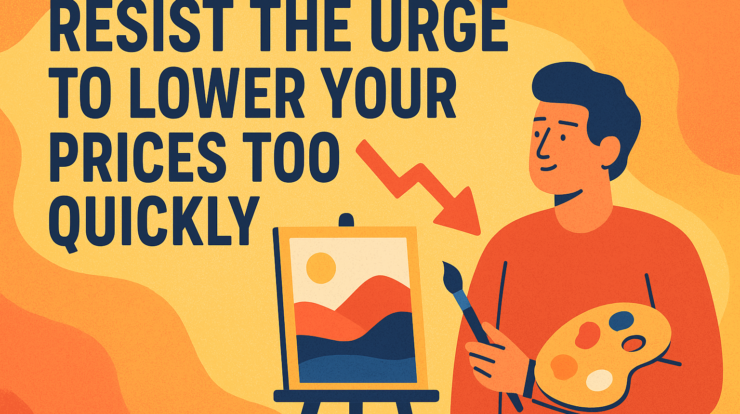
You’ve done the work. You’ve created strong pieces, prepared for an event, set up your booth or hung the show, and had great conversations with potential buyers. People stop, look, compliment your work—and then walk away.
No red dots. No sales. Just smiles and kind words.
It’s easy to walk away from an experience like that with one conclusion: My prices must be too high.
That conclusion feels logical. After all, the art didn’t sell—so maybe if it had just been priced a little lower, people would’ve bought. Right?
Not necessarily.
Price Is the Easiest (and Least Effective) Variable to Blame
When a sale doesn’t happen, price is the first target. It’s also the most dangerous. That instinct—while understandable—can lead you down a path that undercuts your credibility and damages your long-term business.
The truth is, price is rarely the sole reason someone doesn’t buy. There are dozens of other variables at play: the venue, the timing, the buyer’s personal situation, the overall economic climate, even simple distractions like heat or crowds.
Most of the time, the work isn’t “too expensive”—it’s just that the right buyer wasn’t there in the right frame of mind. Lowering your price won’t fix that.
Why You Should Hold Your Ground
If you’ve done the work to set your prices thoughtfully—researching the market, evaluating your experience, materials, and time—then that pricing deserves to hold.
Here’s what I’ve seen happen time and again with artists who panic and start cutting:
- They lose confidence in their own value.
- Collectors sense the shift and begin to question whether the work is worth what it once was.
- Future buyers expect discounts or lower pricing.
- Longtime collectors feel like they overpaid.
- The artist makes less while working just as hard (or harder).
A small drop—from $225 to $190, or from $500 to $450—often doesn’t move the needle. It won’t suddenly make your work “affordable.” The kind of person who couldn’t afford the original price still won’t buy—and the person who could may now second-guess the work’s quality or your confidence.
Price Cutting vs. Strategy
Now, there are times when adjusting your pricing makes sense—usually after a pattern has emerged over multiple shows, venues, or seasons. But when you react to one slow show or a single event, you’re not strategizing—you’re reacting.
Instead, view that unsold show as a learning experience. Ask:
- Was this the right venue for my work?
- Did the event draw the right audience?
- How was the event promoted?
- Was I as prepared as I could’ve been in terms of display and engagement?
- Did I collect contacts and build relationships, even if no sales occurred?
One quiet event doesn’t justify overhauling your pricing structure. If you adjust every time sales dip, you won’t have a pricing strategy—you’ll have a pricing panic.
Consider the Bigger Picture
We’re in a season right now where there’s real economic uncertainty. Markets are jittery, people are hesitant, and that hesitation is reflected in how they spend. This may affect how many sales you make—but it doesn’t reflect the quality of your work or its value in the long term.
Art sales often follow a rhythm. There are months where everything moves, and months where nothing moves at all. Experienced artists recognize the pattern and stay focused on what they can control: creating excellent work, presenting it professionally, and showing up consistently.
Stay the Course
If you’ve priced your work thoughtfully, don’t second-guess it based on short-term feedback. Stay the course. Build inventory. Seek out new and better venues. Be consistent.
Pricing is one of the most powerful signals you send about the value of your work. Don’t let short-term discouragement weaken that signal.
The confidence to hold your price is one of the clearest signs you’re running a business, not just creating art. Treat it that way.
Thank you Jason for your advice lowering prices. I participate at Celebration of Fine Art in Scottsdale. I have seen artists do that particularly this year. It is very encouraging to show confidence in our prices.